
French Printmaking. The Debate Over Colors
CLARK ART INSTITUTE. December 11, 2021–March 6, 2022
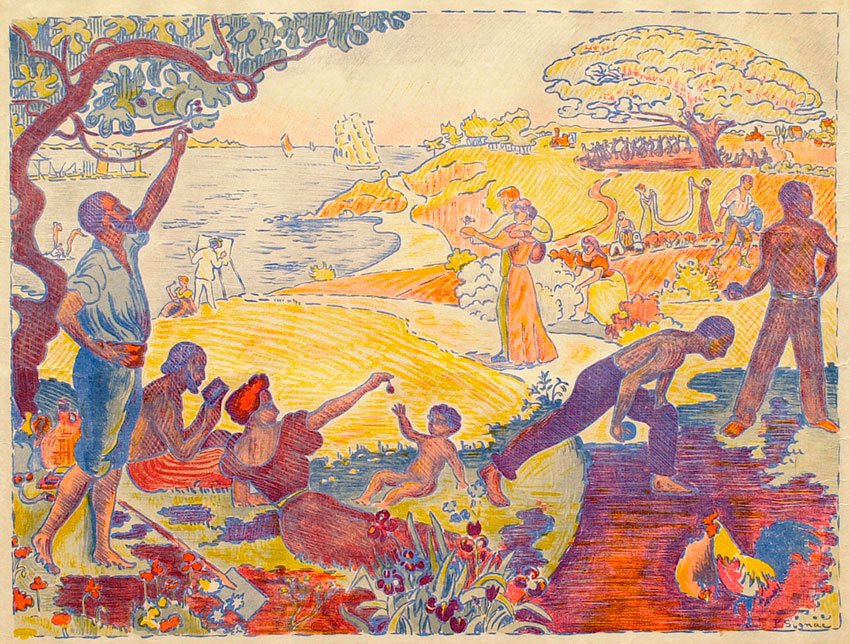
Paul Signac (French, 1863–1935), In the Times of Harmony (Au Temps d’Harmonie), ca. 1896,
color lithograph on paper. Clark Art Institute, 1967.18
The exhibition presents the surprising but steady opposition
to the use of color in printmaking in 19th century France
 Olivier Meslay, Hardymon’s Director of the Clark.
Olivier Meslay, Hardymon’s Director of the Clark.
“Color prints are so widely accepted and beloved today that it is difficult to understand the early opposition these works received,”.
“Critics at the time scorned color printmaking, calling it gaudy, garish, vulgar, cheap, showy, and commercial”. “By the terms of the period, prints were understood as an art of black and white; if a print had color, it failed to qualify as fine art and had to be considered within some other classification, like illustration or advertising”.
“While the controversy over color may seem quaint, this exhibition tells a fascinating story to explain how the art world confronted this change”
France’s First Color Heyday, 1760–1790
Since the Renaissance, chiaroscuro woodcut had been the most reliable technique of printing blocks of color, but it was inadequate to render more fine-tuned chromatic effects. By the late 1700s, attention turned to the possibilities of color intaglio (copperplate) printing, which offered greater subtlety.
Color prints had already attained a zenith of technical perfection in France, but their popularity did not last. Extremely costly, and intimately associated with the decadence of the monarchy, these exquisite, printed confections saw both their relevance and their primary clientele disappear abruptly in the wake of the French Revolution.
Philibert Louis Debucourt
The Two Kisses. 1786
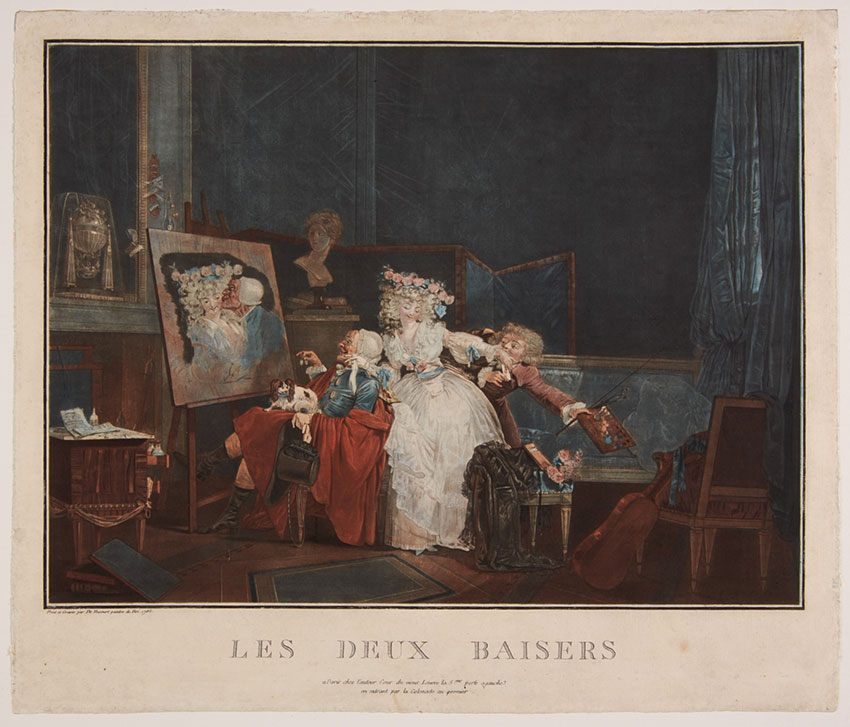 Philibert Louis Debucourt (French, 1755–1832), The Two Kisses (Les deux baisers), 1786, colored aquatint on laid paper. Clark Art Institute, 1955.1871
Philibert Louis Debucourt (French, 1755–1832), The Two Kisses (Les deux baisers), 1786, colored aquatint on laid paper. Clark Art Institute, 1955.1871
Philibert Louis Debucourt
The Climb, or Morning Farewell. 1787
 Philibert Louis Debucourt (French, 1755–1832), The Climb, or Morning Farewell (L’escalade ou les adieux du matin), 1787, color intaglio on paper. Clark Art Institute, 1955.1897
Philibert Louis Debucourt (French, 1755–1832), The Climb, or Morning Farewell (L’escalade ou les adieux du matin), 1787, color intaglio on paper. Clark Art Institute, 1955.1897
A Century Later: Return to Color Intaglio
Tarred by its prior associations with frivolity and excess, color printmaking lay dormant in France’s fine-art realm for most of the nineteenth century. Following the opening of Japan to the West in the 1850s, however, Japanese color woodblock prints began to arrive in Paris and artists and collectors alike took notice.
Because the color woodblock process, reliant on a workshop-style division of labor in Japan, was impractical for most individual artists to attempt, they sought instead to replicate the effects using intaglio processes.
Mary Cassatt
Mother’s Kiss, 1891
Famed set of ten color aquatints inspired by ukiyo-e prints was just one of the experiments being attempted by printmakers at the time.
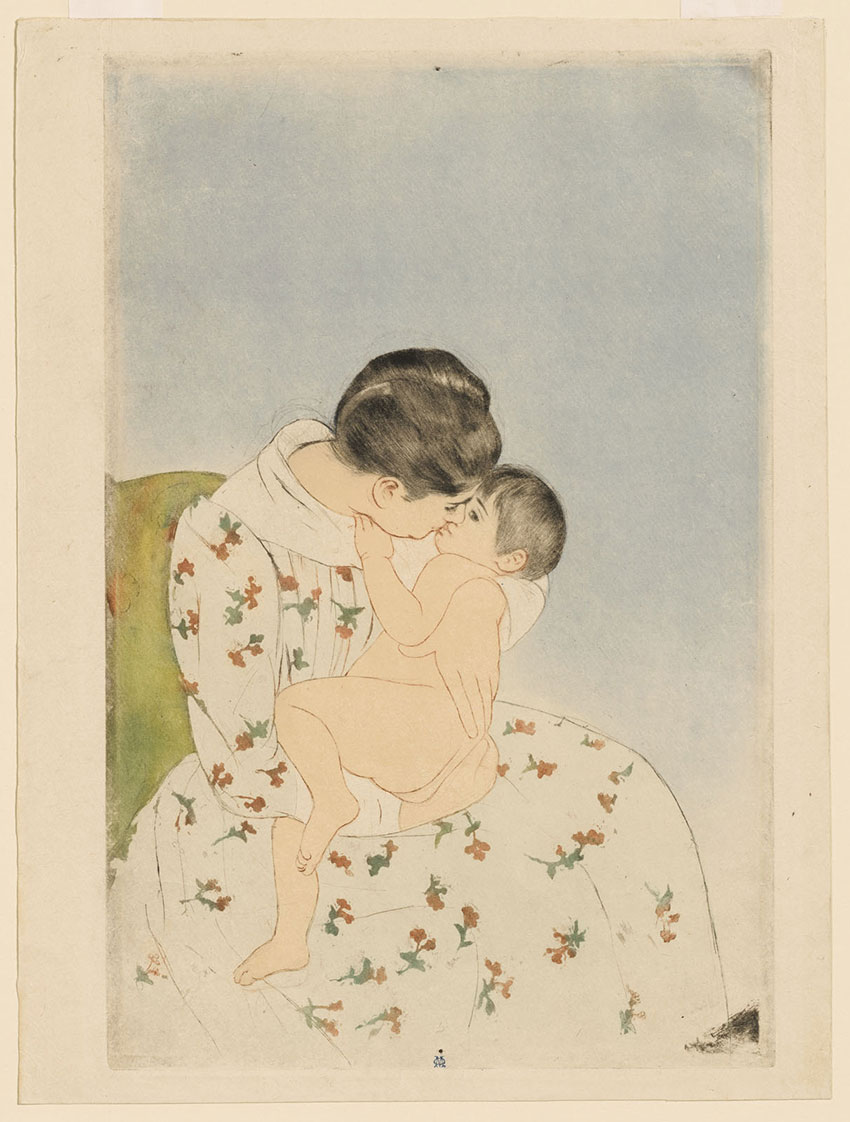
Mary Cassatt (American (active in France), 1844–1926), Mother’s Kiss, 1891, color drypoint and aquatint. Clark Art Institute, 1955.1409
Eugène Delâtre
Little Girl with a Pail, 1893
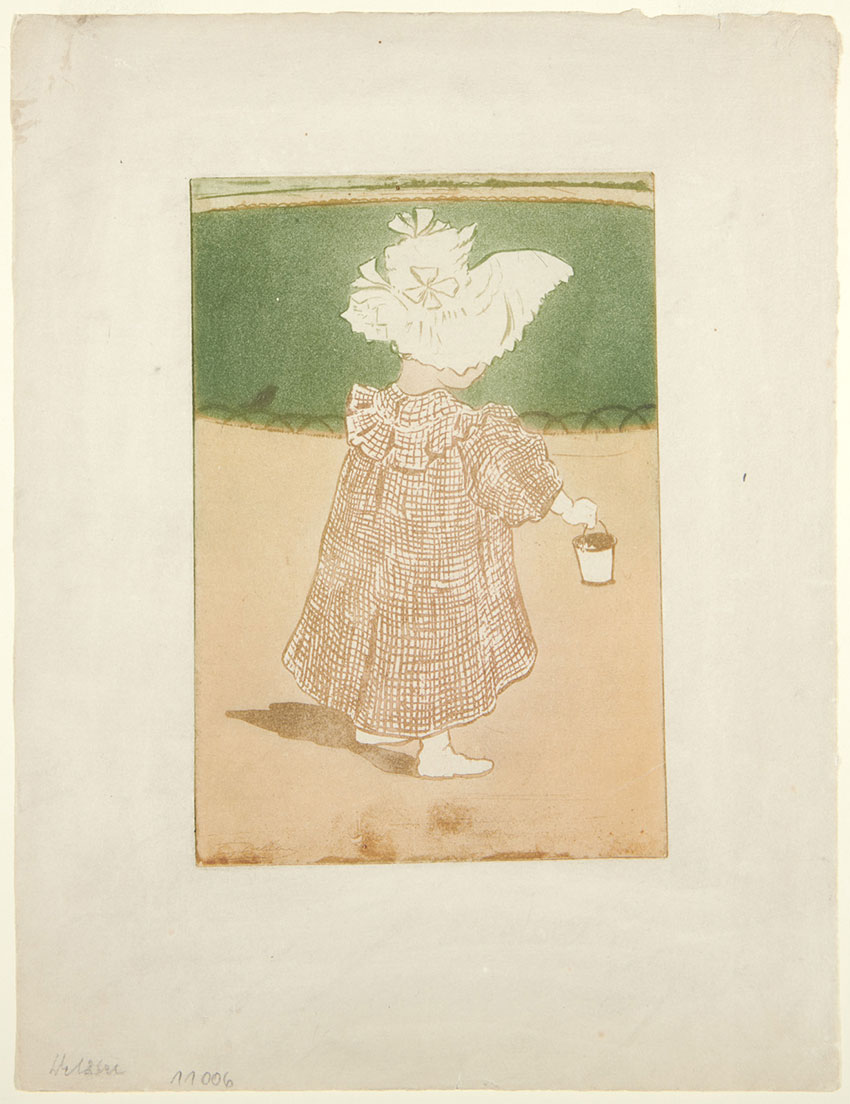
Eugène Delâtre (French, 1864–1938), Little Girl with a Pail, 1893, color etching and aquatint on laid paper. Clark Art Institute, 1988.215
Camille Pissarro
Peasant Women Weeding the Grass, c. 1894
Peasant Women Weeding the Grass (c. 1894) includes precious notations in pencil about Pissarro’s color intentions. They may be notes to a technician about desired effects.
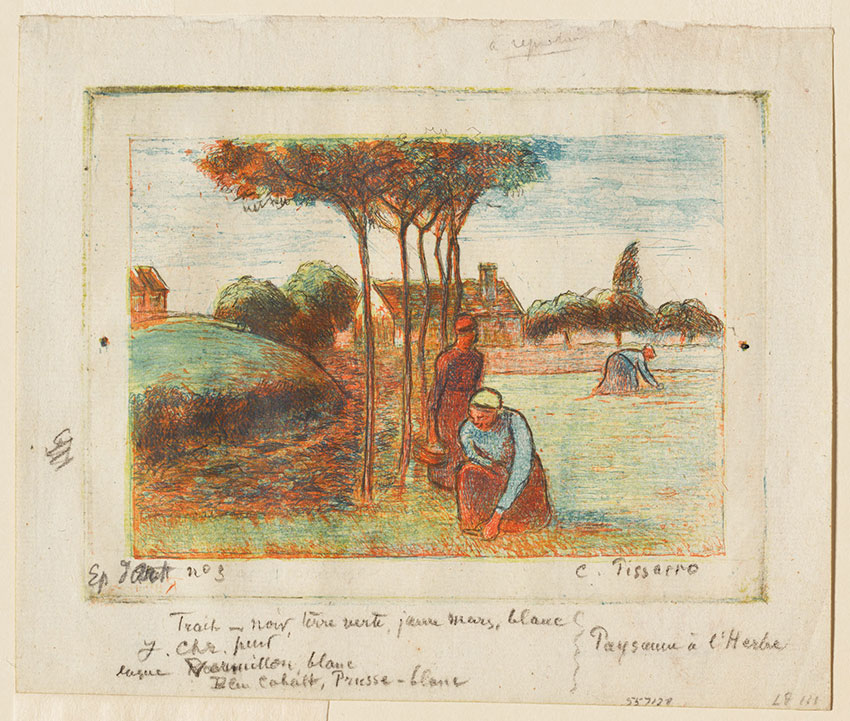 Camille Pissarro (French, 1830–1903), Peasant Women Weeding the Grass, c. 1894, etching printed in blue, red, yellow, and black on cream laid paper. Clark Art Institute, 1962.91
Camille Pissarro (French, 1830–1903), Peasant Women Weeding the Grass, c. 1894, etching printed in blue, red, yellow, and black on cream laid paper. Clark Art Institute, 1962.91
Camille Pissarro
The Gisors Market, Rue Cappeville, ca. 1894
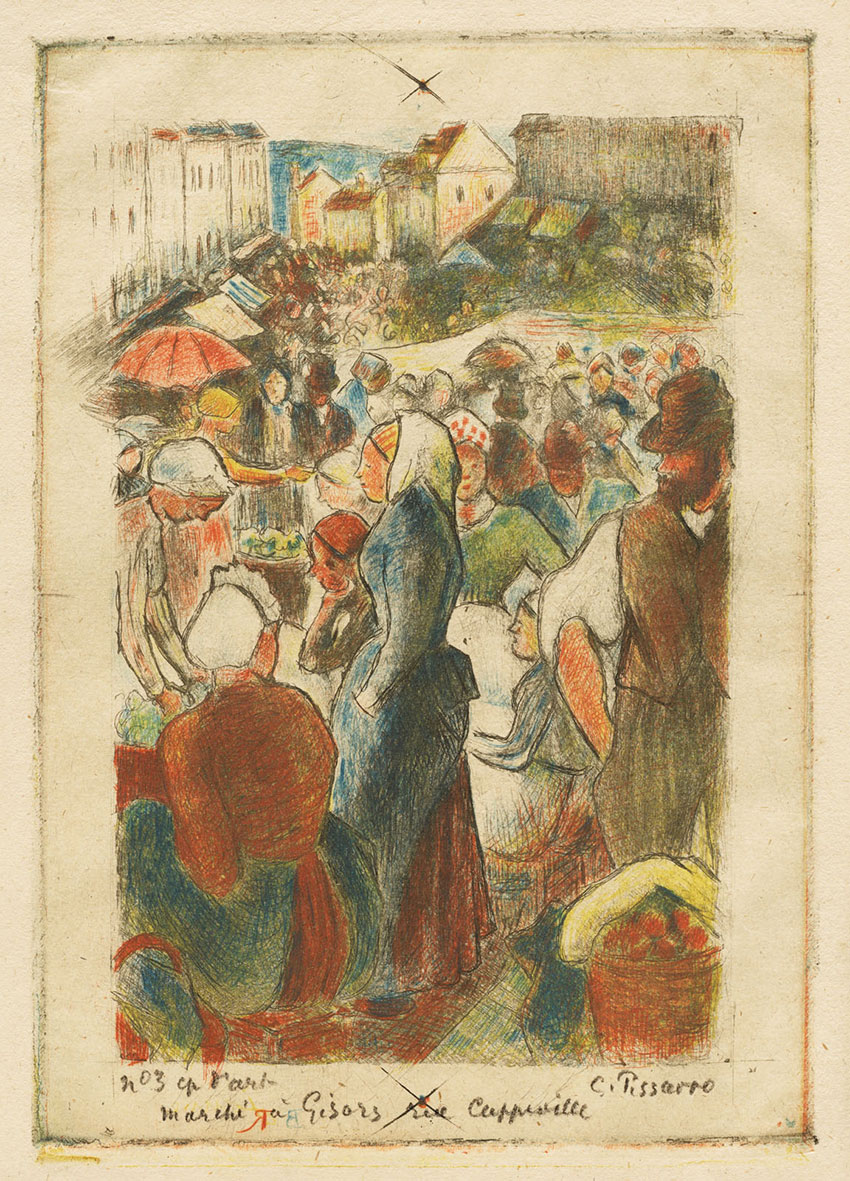 Camille Pissarro (French, 1830–1903), The Gisors Market, Rue Cappeville, ca. 1894. Color etching on paper, sheet: 10 11/16 x 7 11/16 in. Clark Art Institute, 1962.93
Camille Pissarro (French, 1830–1903), The Gisors Market, Rue Cappeville, ca. 1894. Color etching on paper, sheet: 10 11/16 x 7 11/16 in. Clark Art Institute, 1962.93
Color intaglio works were usually printed in small editions, making them rare today. Many notable artists of the period avoided color intaglio, however, perhaps because of the need to relinquish the printing process to a technician. The challenge to unitary authorship was yet another reason that objections to color printmaking persisted in this period.
Color Lithography Hits the Streets:
Toulouse-Lautrec and Chéret
Color lithography, invented in 1798 as an efficient method of reproducing sheet music, commercial printed matter, newsprint illustrations, and other ephemera in near-industrial quantities, lithography stood in opposition to the aesthetically motivated intaglio techniques, characterized by small print runs.
Color lithography was, however, an ideal medium for advertising posters, which emerged as a new language of the modern city. Posters by Jules Chéret (French, 1836–1932), Henri de Toulouse-Lautrec (French, 1864–1901), and others—publicizing everything from the night spots of the Montmartre entertainment district to skating rinks and cough drops—rose from an “art of the street” to become the most distinctive feature of 1890s visual culture.
Jules Chéret
Vin Mariani, 1894–95
Chéret earned the title “father of the modern poster.” In Vin Mariani (1894–95), Chéret sought to convey the euphoric effects of Vin Mariani, the first commercial cocaine-based beverage developed by Parisian chemist Angelo Mariani in 1863.
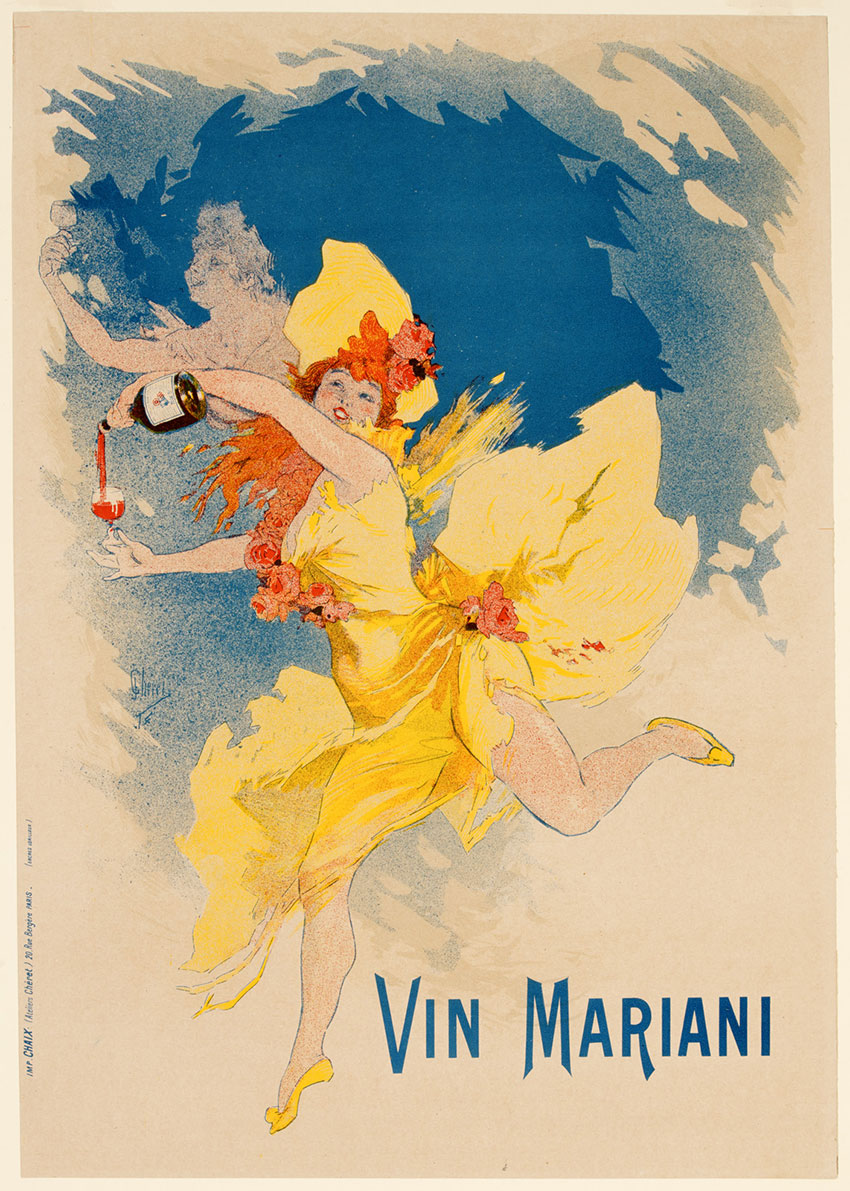
Jules Chéret (French, 1836–1932), Vin Mariani, 1894–95, color lithograph on paper. Clark Art Institute, 1955.2390
Henri de Toulouse-Lautrec
Mademoiselle Marcelle Lender, Bust-Length, 1895
Toulouse-Lautrec recorded the dance halls and brothels of Montmartre, often using recognizable actresses, notables, and dancers in his pictures. Adopts the flat color planes, cropped composition, and shallow spatial recession of Japanese ukiyo-e prints. In his scenes of theaters, cabarets, and dance halls, Toulouse-Lautrec often trained his attention more closely on the spectators than the performers.

Henri de Toulouse-Lautrec (French, 1864–1901), Mademoiselle Marcelle Lender, Bust-Length, 1895, lithograph printed in brown-green, yellow, red, dark pink, green, blue, gray, and yellow-green on cream wove paper. Clark Art Institute, Clark Art Institute, 1955.1442
Henri de Toulouse-Lautrec
Balcony with a Gilded Grotesque Mask, 1894
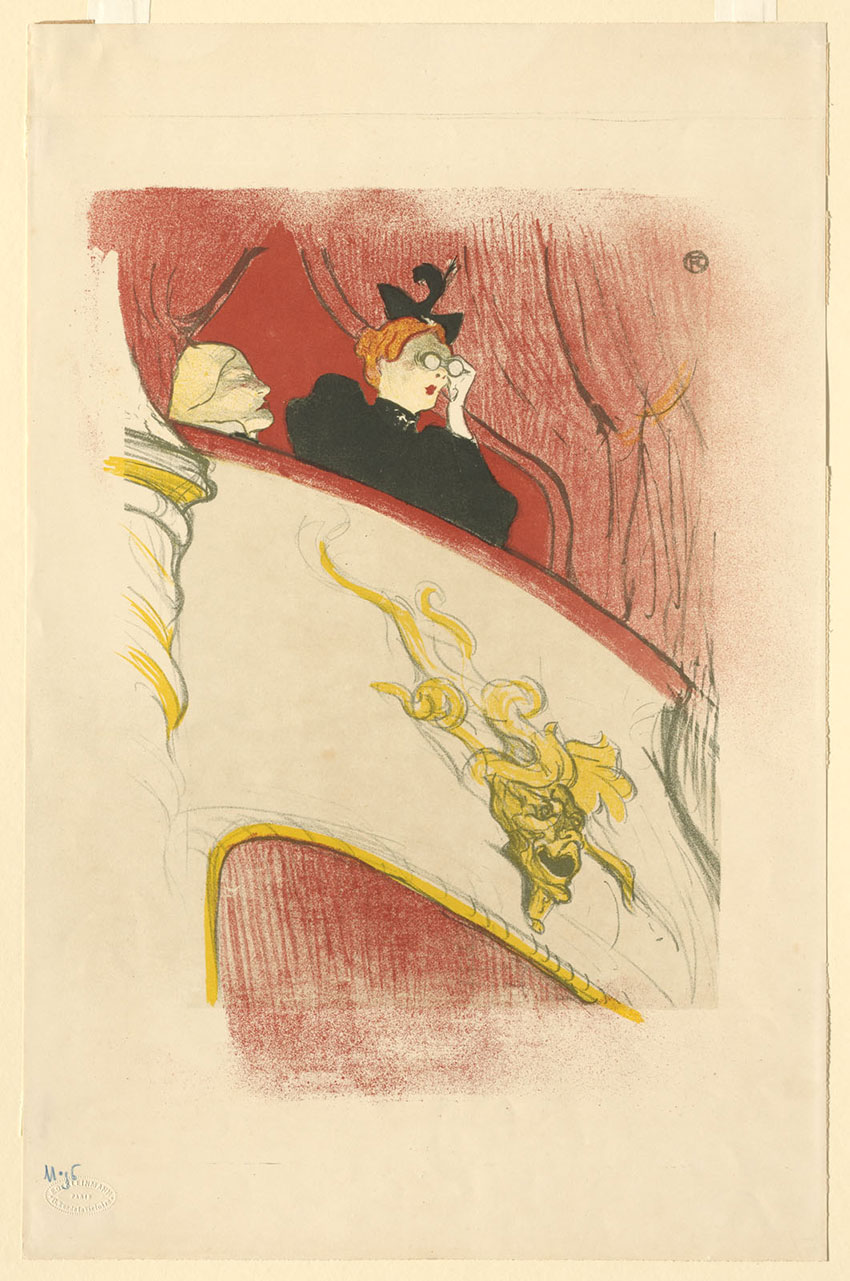
Henri de Toulouse-Lautrec (French, 1864–1901), Balcony with a Gilded Grotesque Mask, 1894, color lithograph. Clark Art Institute, 1955.1434
Henri de Toulouse-Lautrec
The Englishman at the Moulin Rouge, 1892
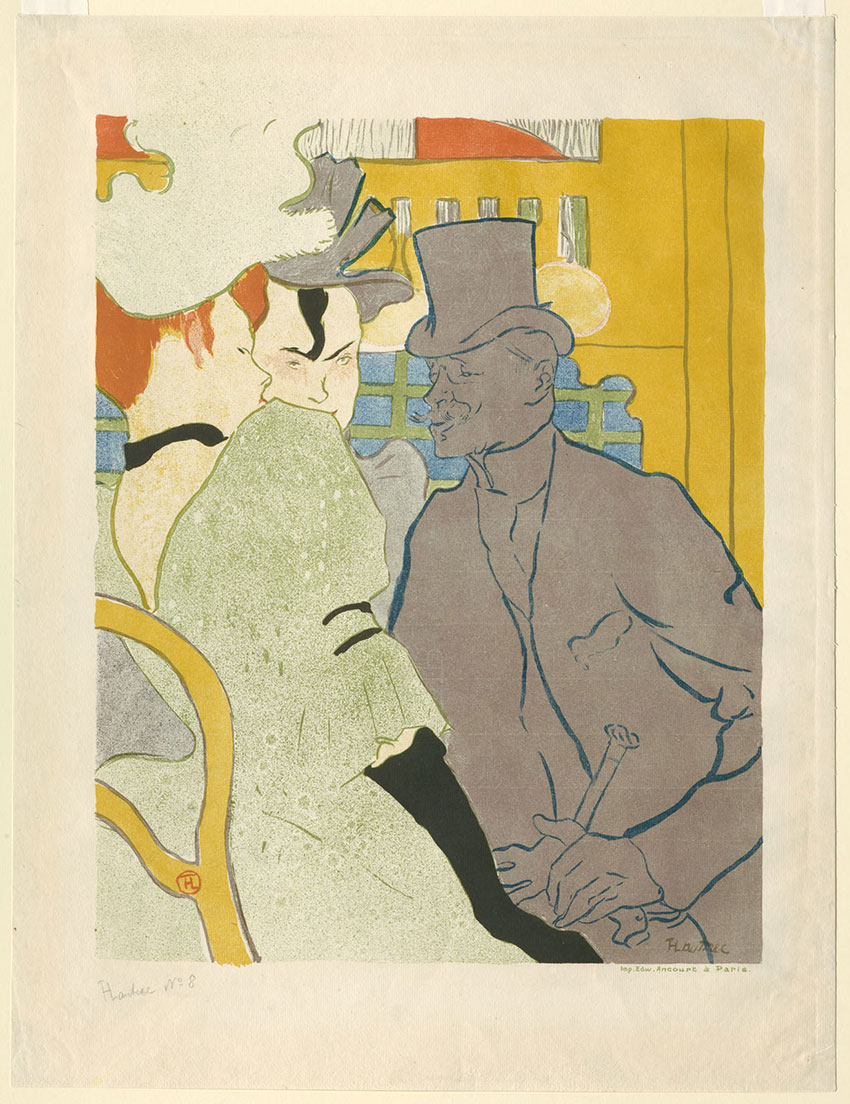
Henri de Toulouse-Lautrec (French, 1864–1901), The Englishman at the Moulin Rouge, 1892, lithograph printed in green, gray, blue, orange red, yellow, and black on cream laid paper. Clark Art Institute, 1968.17
Henri de Toulouse-Lautrec
At the Moulin-Rouge: La Goulue and Her Sister, 1892

Henri de Toulouse-Lautrec (French, 1864–1901), At the Moulin-Rouge: La Goulue and Her Sister, 1892, color lithograph on paper. Clark Art
Color Lithography: But Is It Art?
One great advantage of lithography, by contrast with intaglio or woodblock methods, was that artists could draw freely on the stone matrix or transfer a design directly from another surface without the need for specialized tools. The operations required to produce a design for print thus corresponded more closely to those for drawing or painting, while lithography’s adaptable character enabled an almost unlimited range of aesthetic effects.
Paul Signac
In the Times of Harmony (Au Temps d’Harmonie), ca. 1896

Paul Signac (French, 1863–1935), In the Times of Harmony (Au Temps d’Harmonie), ca. 1896, color lithograph on paper. Clark Art Institute, 1967.18
Signac’s anarchist political bent suggests that his future vision of harmony for human society would require a destruction of the present order. In the Time of Harmony (Au temps d’harmonie) (c. 1896) is subtitled with a phrase that translates to “the golden age is not in the past, it is in the future.”
Paul Signac
Le Port de Saint-Tropez II, c. 1897–98
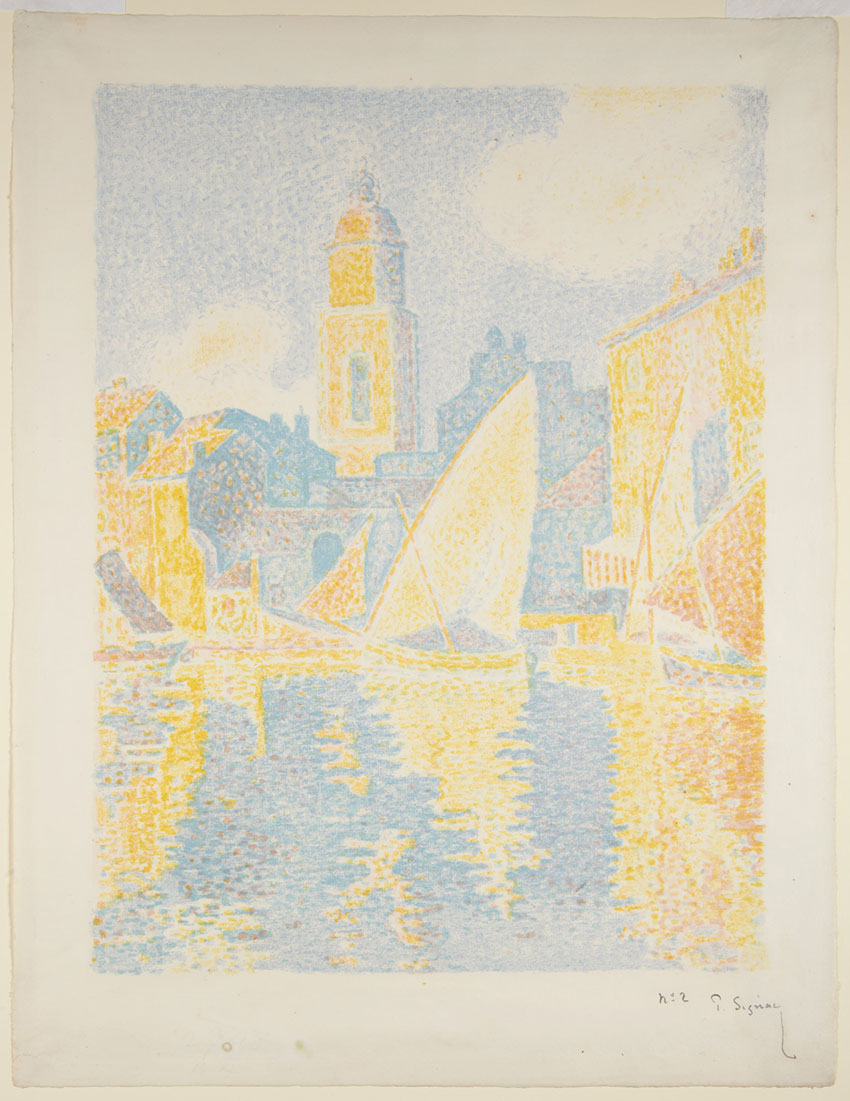
Paul Signac (French, 1863–1935), Le Port de Saint-Tropez II, c. 1897–98. Color lithograph on wove paper, sheet: 20 1/2 x 15 3/4 in. Clark Art Institute, Gift of Susan W. and Stephen D. Paine, 1986.121
Four Nabi Portfolios
Produced in the same medium as the posters of Toulouse-Lautrec, but possessing an opposite sensibility, the lithographs in the Nabi portfolios represent the pinnacle of color printmaking in the very last years of the nineteenth century. In these intimate prints—intended for private, domestic enjoyment—Bonnard, Maurice Denis (French, 1870–1943), Ker-Xavier Roussel (French, 1867–1944), and Édouard Vuillard (French, 1868–1940) deploy the raw materials of lithography to produce intensely personal reflections on landscape, the modern city, and even conjugal love. As the portfolios were often split apart and sold as individual sheets.
Pierre Bonnard
The Little Laundress (La petite blanchisseuse), 1896
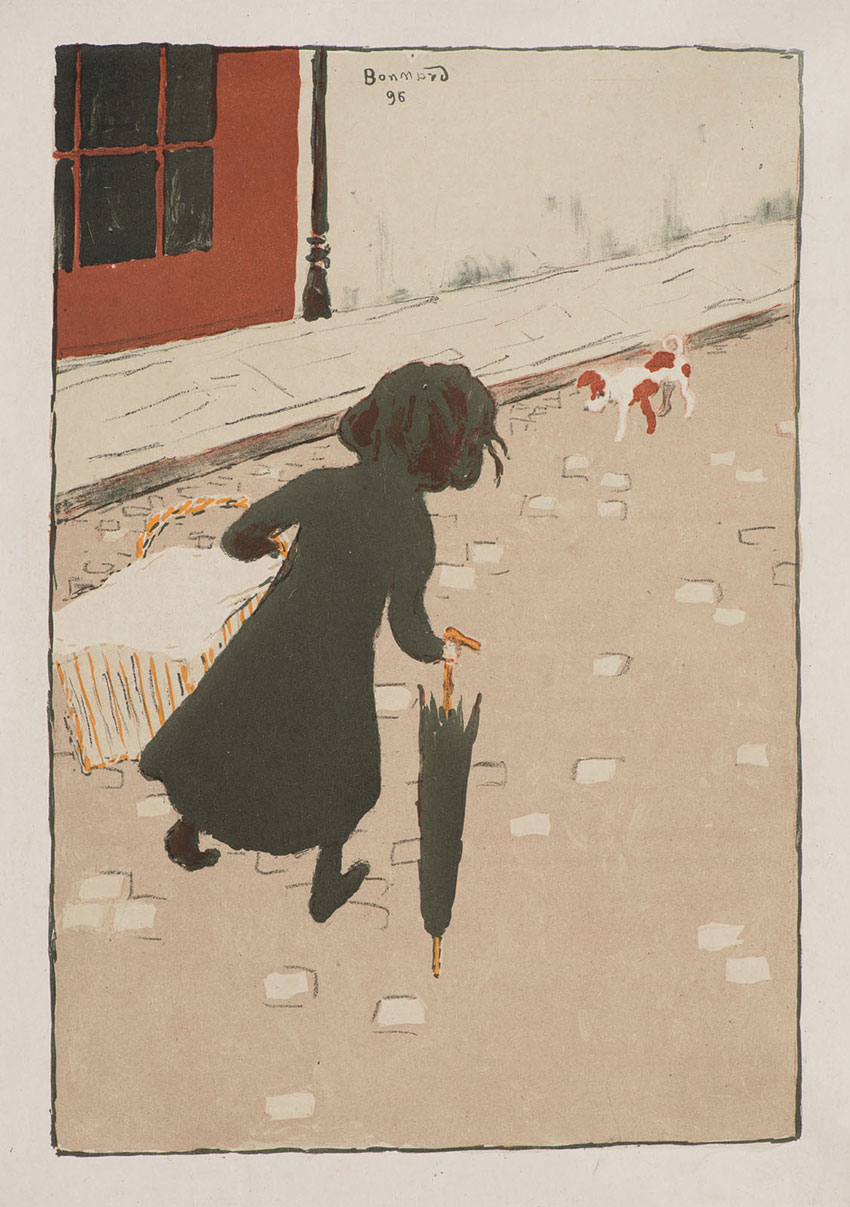
Pierre Bonnard (French, 1867–1947), The Little Laundress (La petite blanchisseuse), 1896, lithograph in deep red, orange yellow, bistre, gray-black, grayish beige, on China paper. Clark Art Institute, 1962.7
Pierre Bonnard
The Orchard (Le verger), 1899
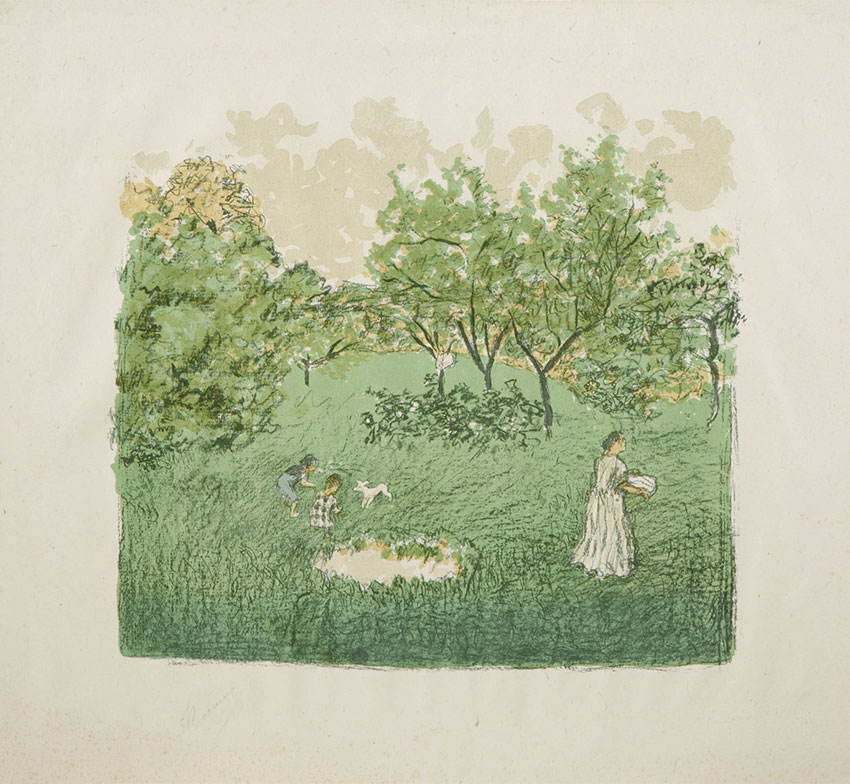
Pierre Bonnard (French, 1867–1947), The Orchard (Le verger), 1899. Lithograph in green, light blue, yellow, beige, black on China paper, sheet: 17 11/16 x 22 1/8 in. Clark Art Institute, 1962.10
Pierre Bonnard
Some Aspects of Life in Paris, 5, 1898
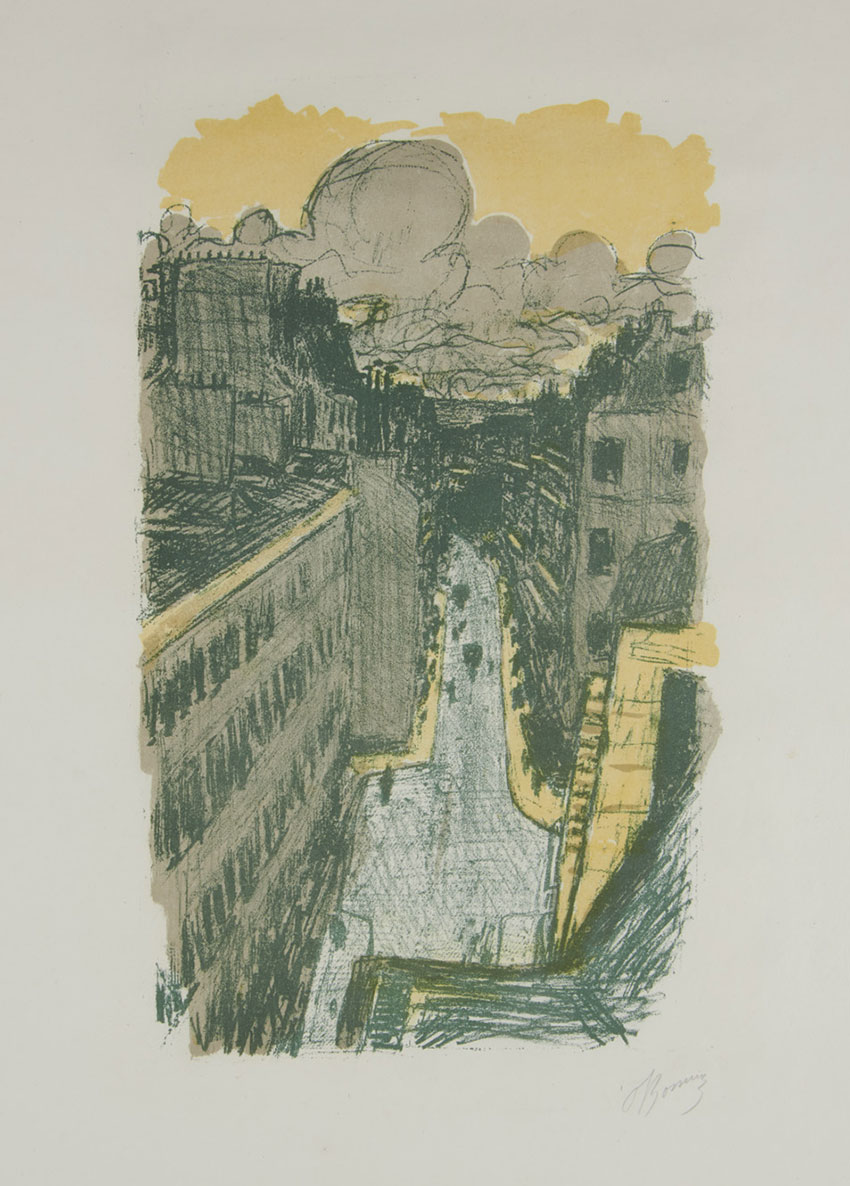 Pierre Bonnard (French, 1867–1947), Some Aspects of Life in Paris, 5: Street Seen from Above (Quelques aspects de la vie parisienne: Rue vue d’en haut), c. 1898, lithograph in yellow, beige, light green deep green on laid paper. Clark Art Institute, 1962.19
Pierre Bonnard (French, 1867–1947), Some Aspects of Life in Paris, 5: Street Seen from Above (Quelques aspects de la vie parisienne: Rue vue d’en haut), c. 1898, lithograph in yellow, beige, light green deep green on laid paper. Clark Art Institute, 1962.19
Édouard Vuillard
Landscapes and Interiors: Interior with Pink Wallpaper I, 1899
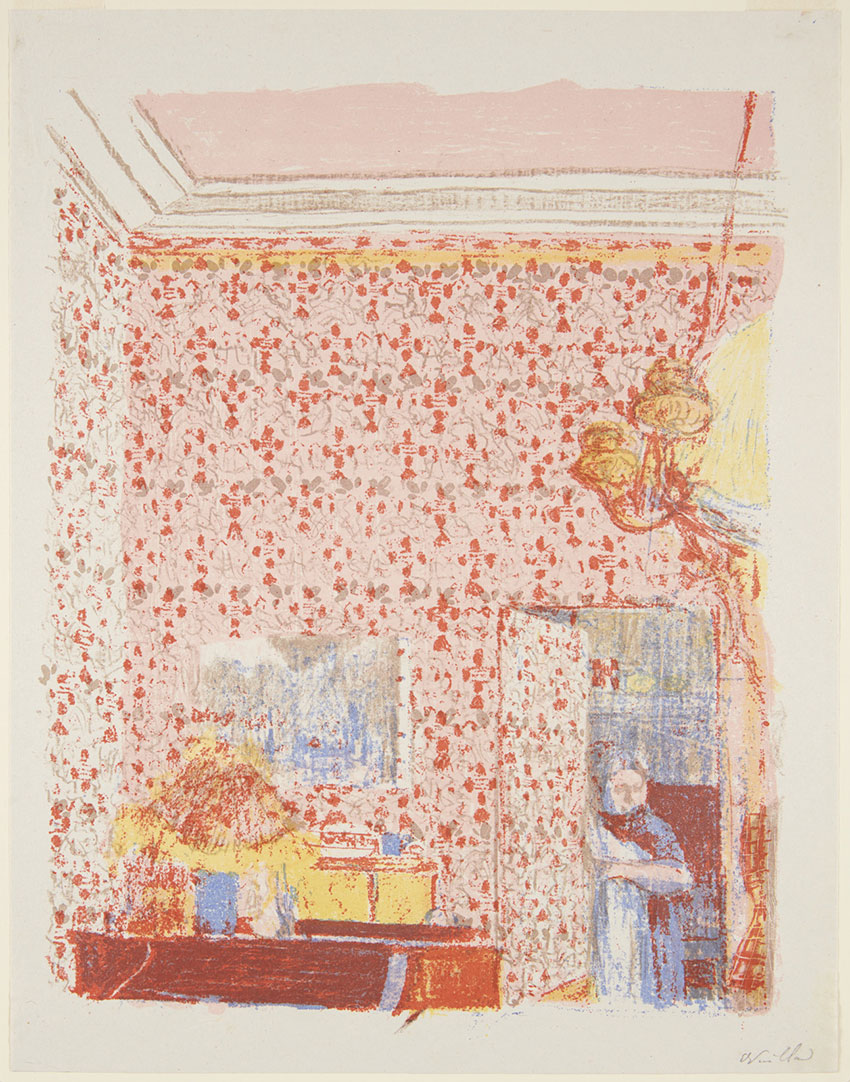
Édouard Vuillard (French, 1868–1940), Landscapes and Interiors: Interior with Pink Wallpaper I, 1899. Lithograph on paper, sheet: 15 7/16 x 12 3/16 in. Clark Art Institute, 1962.131
Édouard Vuillard
Landscapes and Interiors: Through the Fields, 1899
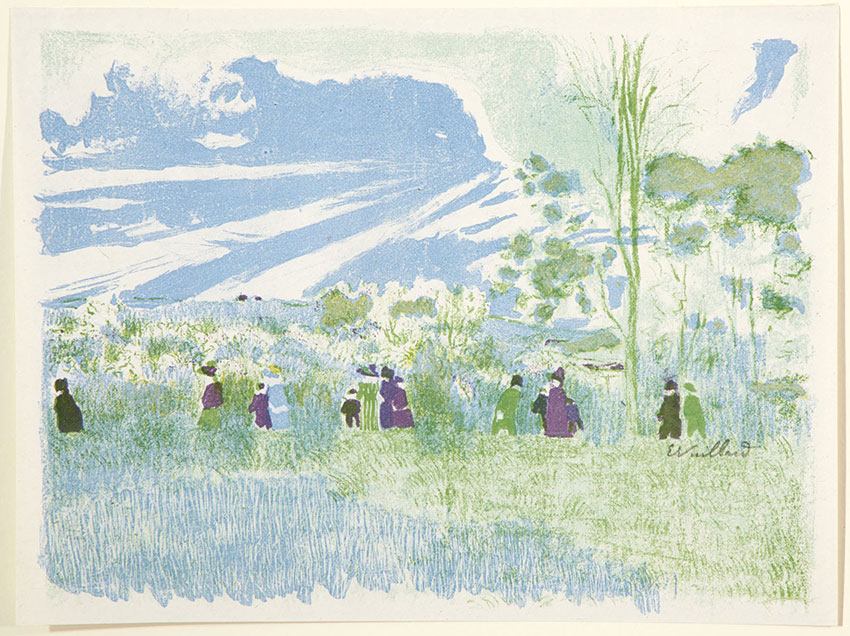
Édouard Vuillard (French, 1868–1940), Landscapes and Interiors: Through the Fields, 1899, lithograph on paper. Clark Art Institute, 1962.129
Ker-Xavier Roussel
Landscapes: Figure in a Striped Dress, 1898
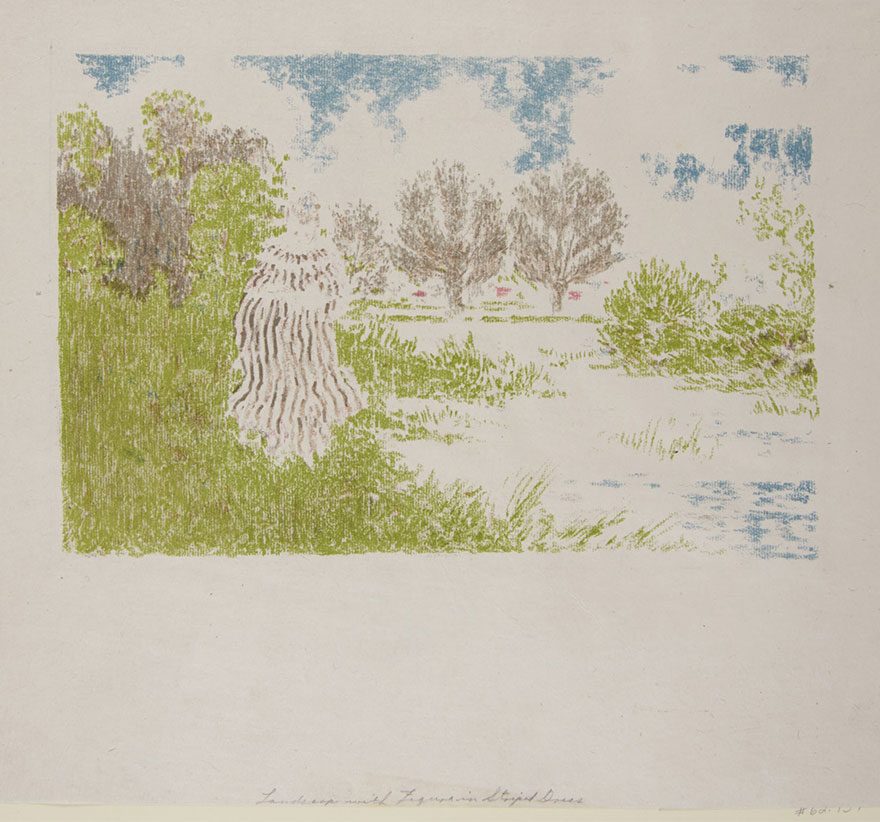
Ker-Xavier Roussel (French, 1867–1944), Landscapes: Figure in a Striped Dress, 1898, lithograph on paper.
Clark Art Institute, 1962.139
Maurice Denis
Love: Twelve Lithographs in Color: Cover, 1898
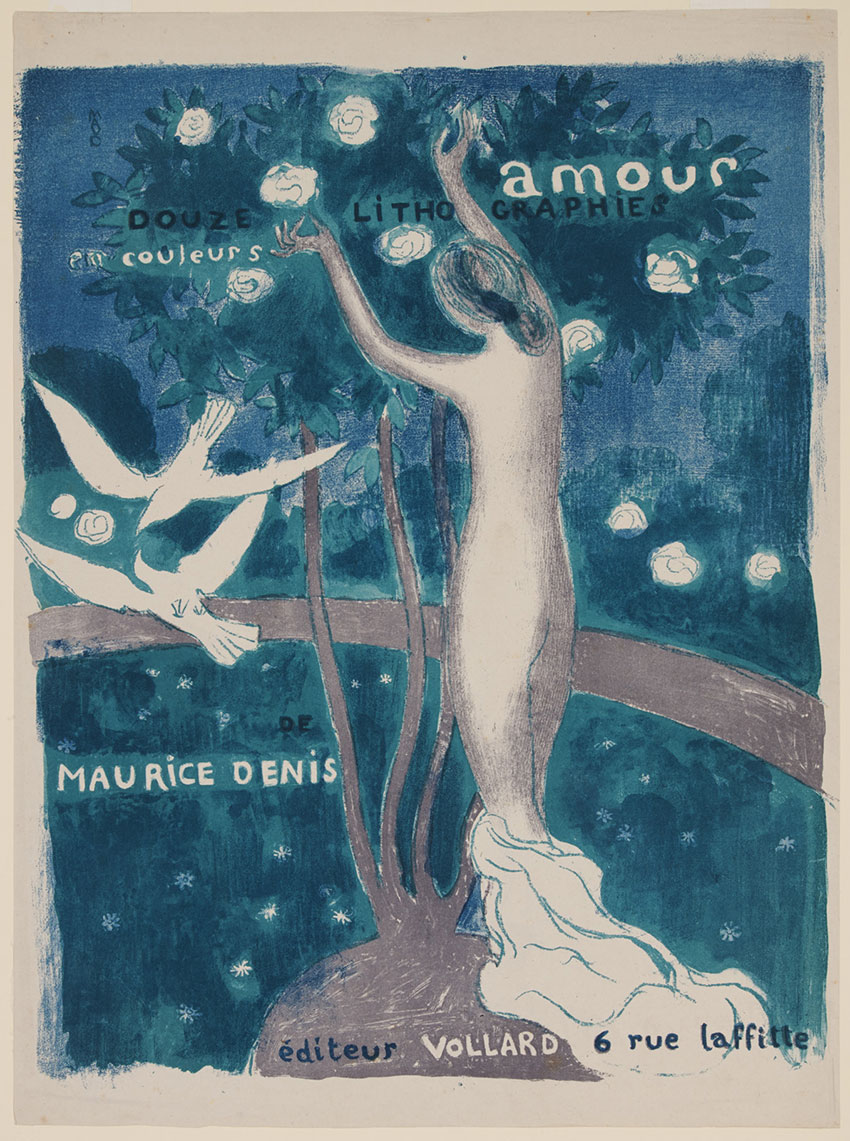
Maurice Denis (French, 1870–1943), Love: Twelve Lithographs in Color: Cover, 1898, color lithograph on china paper. Clark Art Institute, 1962.42
Paul Cézanne
The Bathers: Large Plate, 1898
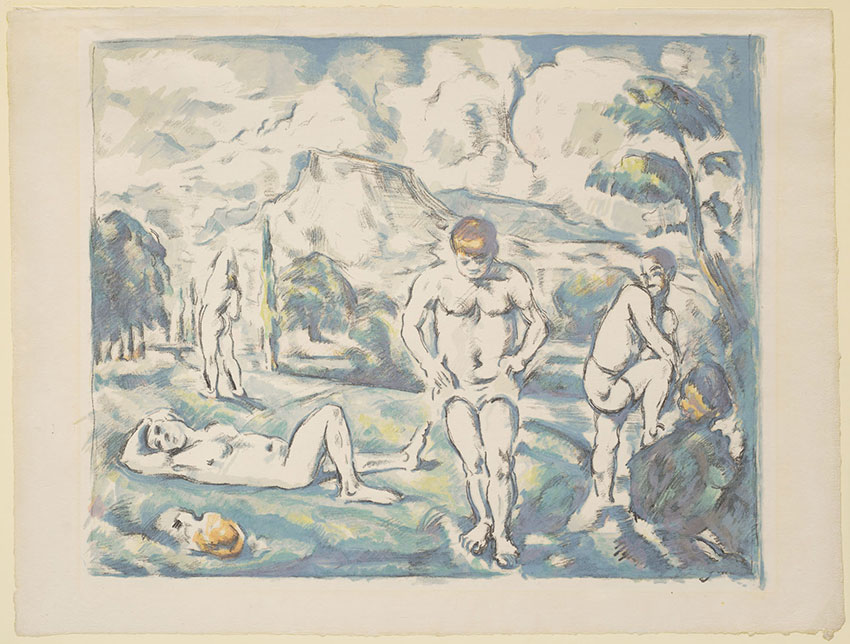
Paul Cézanne (French, 1839–1906), The Bathers: Large Plate, 1898. Lithograph printed in black, green, yellow-green, orange, gray, blue, and purple-blue on cream laid paper, sheet: 19 x 24 13/16 in. Clark Art Institute, 1962.26
Paul Cézanne
The Small Bathers, 1897
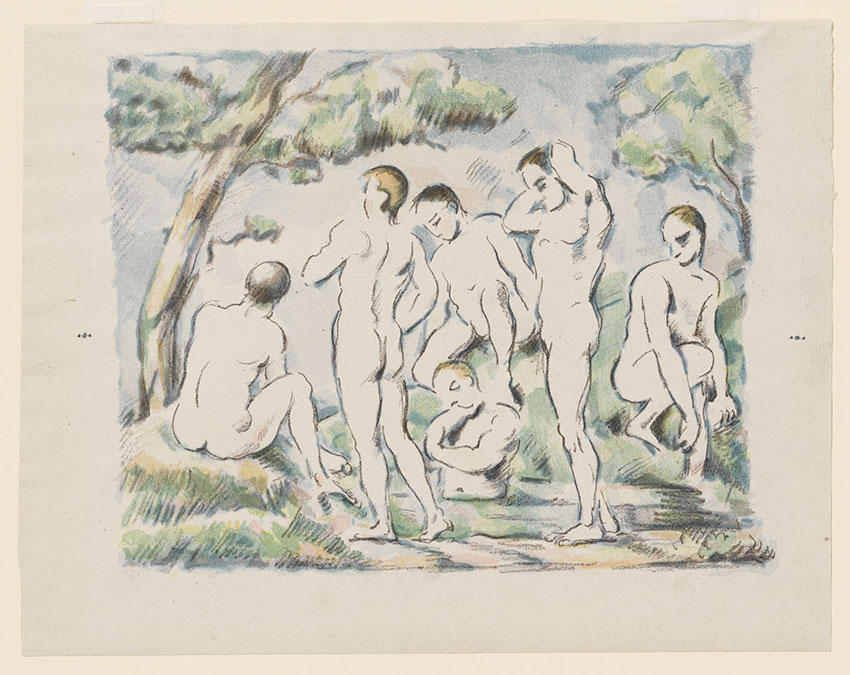
Paul Cézanne (French, 1839–1906), The Small Bathers, 1897, color lithograph. Clark Art Institute, 2012.14
The exhibition is organized by the Clark Art Institute and curated
by Anne Leonard, Manton Curator of Prints, Drawings, and Photographs.
Hue & Cry: French Printmaking and the Debate over Colors
is made possible by Denise Littlefield Sobel.
CLARK ART INSTITUTE
225 South Street Williamstown, MA 01267, P (413) 458 2303
https://www.clarkart.edu